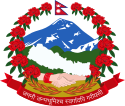Rastriya Sabha
|
National Assembly राष्ट्रिय सभा |
|
|---|---|

Emblem of Nepal
|
|
| Type | |
| Type | |
| Leadership | |
|
Chairperson
|
Ganesh Prasad Timilsina, CPN UML
Since 15 March 2018 |
| Structure | |
| Seats | 59 |
 |
|
|
Political groups
|
Government (43) Opposition (13)
Others (3)
|
|
Length of term
|
6 years |
| Elections | |
| Indirect single transferable vote | |
|
Last election
|
06 February 2018 |
|
Next election
|
2024 |
| Meeting place | |
 |
|
| International Convention Centre, New Baneshwor, Kathmandu, Nepal | |
| Website | |
| na |
|
Government (43)
Opposition (13)
Others (3)
The National Assembly (राष्ट्रिय सभा; Rastriya Sabha) is the upper house of the bicameral Federal Parliament of Nepal, the lower house being the House of Representatives. The composition and powers of the Assembly are established by Part 8 and 9 of the Constitution of Nepal. There are a total of 59 members: 8 members are elected from each of the seven states by an electoral college of each state, and three are appointed by the President on recommendation of the government.
Members serve staggered six year terms such that the term of one-third members expires every two years.
The National Assembly under the 1990 Constitution was dissolved on 15 January 2007 and replaced by a unicameral Interim Legislature. Following two Constituent Assembly elections which also served as an unitary Legislature Parliament, the Constitution of Nepal provisioned for a National Assembly as an upper house.
The qualifications for being a member of National Assembly are laid out in Article 87 of the constitution and National Assembly Election Act, 2017:
Each of the seven states elects 8 members each.
The electoral college consists of members of the State Assembly and Chairperson/Mayor and Vice Chairperson/Deputy Mayor of the local bodies within the state. Each State Assembly members vote has a weight of forty eight whereas each Chairperson/Mayor/Vice Chairperson/Deputy Mayor vote has a weight of eighteen.
Out of the eight members from each state, three must be women, one must be a Dalit, and one must be a disabled person or from a minority community. Each elector gets four ballots: one for the three open seats, one for the three female seats, one for the dalit seat and one for the disabled or minority seat. The three open seats and the three female seats are filled by STV, the two other seats by FPTP.
The election is conducted by the Election Commission.
...
Wikipedia
